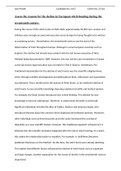Jack Powell Candidate No. 6157 Centre No. 27116
Assess the reasons for the decline in European witch-hunting during the
seventeenth century.
During the course of the witch hunts of 1560-1660, approximately 50,000 men, women and
children were wrongly accused and executed across Europe for being thought to be witches
or practicing sorcery. Nevertheless, the seventeenth century saw the start of the
deterioration of trials throughout Europe. Although in some European countries such as
England, this decline had already been evident with the last known execution of Alice
Molland being documented in 1684. However, this was not the case everywhere in Europe
as the last known legal execution was recorded in 1782 in Glaurus, Switzerland. The
traditional interpretation for the decline of witch hunts was the scientific enlightenment,
which through scientific developments and philosophical ideas, witlessness and superstition
was defeated. This is reinforced by the opinion of Peter Elmer, as he credits the decline of
witch hunts to new scientific knowledge deposing outdated scientific and medical opinion.
For example, the Royal Society introduced new critical thinking. This allowed for new
knowledge to become widespread. Therefore, it undermined the belief in witchcraft.
Significant individuals included the likes of Gailleo, Newton and Johannes Kepler who
introduced theories about the universe which displaced old-fashioned opinions. Moreover,
other individuals such as Rene Descartes and John Locke introduced the concept of
objectivity as a new scientific feature. However, this traditional argument is flawed as it is
believed that the scientific revolution happened after the end of witch-hunting. As a result,
this makes the relationship harder to establish. For example, in 1638 Rene Descartes
published ‘Disclosure on the Method’. By this time, the witch hunts were already declining.
This implies that different factors influenced the decline of witch hunts such as scepticism
and legal changes. Another explanation for the reason of decline in the seventeenth century
[Type here]
,Jack Powell Candidate No. 6157 Centre No. 27116
is the scepticism of religionists and educated elites. The societal convergence between
upper and lower class made resources more accessible allowing new ideas to spread
further. Religionists such as Thomas Ady trusted the Bible, as they argued that it
contradicted beliefs in witch-hunting. However, not everyone held this view such as Joseph
Glanvil, who was the most notable advocate of witchcraft. Also, scepticism of the educated
elites was a reason for the decline in the seventeenth century as they questioned the threat
posed by witches and introduced optimism. Their status in society also provided them with
a basis that allowed them to make more effective changes to bring prosecutions to an end.
Legal changes are the most convincing reason for why the decline took place because
legislation was becoming stricter, and judges began to question evidence brought to them.
Once legal changes were put into place, the decline of witch prosecutions began. This is
evident as individuals such as Sir John Holt secured many discharges due to his
unwillingness to convict. Historians such as Brian Levack argues that the decline of witch-
hunting was due to judiciary scepticism and centralised states.1 Correspondingly, a
widespread change in societal opinions on torturing made people more sceptical about why
torture was allowed and thus forced people into thinking about whether the defendants
were only making confessions due to enduring excruciating and agonising pain.
Subsequently, this then led to restrictions on torture and demands for persuasive evidence,
thus leading to the decline. There were many factors that catalysed the decline in European
witch-hunting in the seventeenth century, but the most convincing factor is the legal
changes. This is because it solidified the establishment of new laws and viewpoints of judges
which ultimately led to the decline of witchcraft prosecutions.
1
https://www.sfu.ca/~poitras/Levack_witch-hunts.pdf
[Type here]
, Jack Powell Candidate No. 6157 Centre No. 27116
The traditional explanation for the decline of European witch hunts during the seventeenth
century, which has been suggested by historians such as William Dampier and Peter Elmer,
is scientific enlightenment. Particularly, the scientific developments that occurred in the
seventeenth century which are often considered by some historians as the most pivotal
factor leading to the decline. William Dampier proposed that the changes of attitudes
towards witchcraft was primarily due to the advances in science which slowly defined the
man’s mastery of nature which allowed for the civilised world to gradually discover that it
had ceased to believe in the existence of witches. 2 Dampier’s suggestion is supported by
Elmer, who argued that the scientific revolution had taken the witch trials “out of existence”
due to the overthrow of antiquated scientific and medical opinion following the Scientific
Revolution. 3Johannes Kepler’s work lends credence to Elmer’s interpretation. Johannes
Kepler was a German astronomer and mathematician. He published ‘Astronoma Nova’ in
1609, where he established his first two laws of planetary motion, which brought
transparency to many about the universe, eradicating outdated explanations. 4 Kepler also
published a second book, ‘Harmones Mundi’ where he stated that ‘there is no room for
divine or demonic intervention’ 5. This is indicative to the idea that although scientists of the
time believed that the Devil was real, they also believed in a God who would not permit the
Devil to exert any influence over humans. This is reinforced as Kepler had a personal
2
Sir William Cecil Dampier, ‘A History of Science and Its Relations with Philosophy and Religion’ (4 th
edn, Cambridge, 1996; 1st edn, 1929) pg.144
3
Elmer. P, Science, Medicine and Witchcraft, Witchcraft historiography, Palgrave Macmillan,
Basingstoke, 2007, chapter 3, pg. 33
4
https://www.britannica.com/biography/Johannes-Kepler
5
Barker, Peter, and Bernard R. Goldstein. “Theological Foundations of Kepler's Astronomy.” Osiris, vol. 16,
2001, pp. 88–113. JSTOR, www.jstor.org/stable/301981
[Type here]





